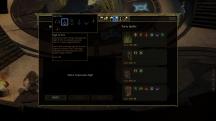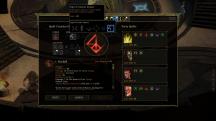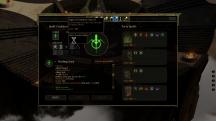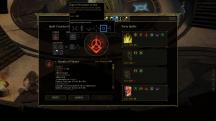Tyranny Preview

For those who have been following Tyranny a bit, you know by now that evil has won and you are one of the leaders of the conquering army and in the game you get the choice to keep being that or that you are going to rebel against the evil overlord and bring something good to the world.
The decision to go for this setting was that Obsidian wanted to do something for a long time already wanted to do something with an evil medieval empire with a bronze age setting, just entering the iron age. All weapons and armory are made from leather or bronze. They feel that this gives a different tone to a fantasy game. Brian Heins is one of the person responsible for choosing this setting and he has a fascination for the bronze age setting and he wanted to set a game at the end of the bronze age, moving to the iron age. Having that point when the technology is changing. One of the reasons that evil has won is because they had the knowledge of melting iron ore and creating iron weapons and armor, which their opponents did not.
At Gamesom, I talked to Obsidian's system designer, Nick Carver. The hands-on demo took us to a dungeon with a predefined party. The party consisted of a mage, which had already been build up by Obsidian to get it to a high enough level to show the spell creation system they have. Then there is a tank character, a ranged character with a bow, who could also easily switch to twin swords for melee. And lastly there was a support character with healing skills. The game has been made with the Pillars of Eternity engine, so if you played that, this game should feel very similar
Spell creation
But before we entered into the hands-on part of the demo, we went into the spell creation system. Spells in the world of Tyranny are not pre-made like in other games. All the spells in the game need to be crafted. While playing the game you will find scrolls and sigils. These are pieces and parts of a spell. By taking different sigils and putting them together you can create different spells and modify them further beyond that. The spell creation system consists of core elements, such as frost, fire, lighting or healing. There are many more in the game, but more were not shown at this stage. I asked how much 'many more' actually is, but Nick did not want to answer that question (Note: after writing this article some screenshots were sent that showed more. See below for some and more in our gallery).
Nick selected frost as the base for the spell. After that he selected an expression sigil, which defines how the spell is shaped in the world. There were only 3 shown, with 'many more' coming. Focused, was the first one, which meant it would be a touch spell and could only be used at closed range and for a single target. The second is a distance spell to cover a long range, like a fire ball and AOE type of spells. The last one allows creating a cone spell, which is like an AOE spell but then using a smaller section. The necessary sigils can be found throughout the game and you can study these to use them later in skill creation.
Once the spell is created it is possible to add accents to the spell. Our main character is a magic user and he has a lore skill of 112. The spell we just created requires a lore skill of 32 to use, so tere is room to make the spell more powerful. By selecting the intensity sigil, the amount of damage that is done is increased as is the required lore to cast the spell. In similar fashion the range can be increased and there are 'many more' accents that can be applied. The more accents that are added to a spell, the higher the required lore skill that is required to cast it will be. Once created the spell can be renamed and personalized, after which you can put it in one of your spell casting slot to make it ready for use.
There is no limit to the amount of spells you can create and you can also give them to your party members. However you do need to have found the parts for the spells you want to create. The icon that is given to the spell is a combination of the core and the expression icons. The accents that are applied to the spell do not change that icon anymore. This means that you can end up with more than one spell in your inventory that looks the same, but act somewhat differently. Nick did mention that there are options to change the icon to something else of your choosing. However, spells that share the same core and expression also share the same cooldown, which makes it less usable to have multiple types of spells in your spell slots.
On the map there are certain structures visible that are referred to as The Old Walls. They are believed to be built by an ancient civilization, but nobody knows for sure. Inside of these walls there are all kinds of ancient artefacts and treasures. They are however very dangerous. Most people that venture inside them are never seen again. The overlord of the world has actually forbidden to enter them. But the party I am playing noticed that someone ran into the walls with an ancient artefact and we are now pursuing that person to get this artefact. Once we obtained that we are hoping that it will justify our reasoning to enter the walls.
Changes
But before we started with the demo, I also wanted to ask about the changes to the mechanics of the game. I knew that there is no friendly fire, so I asked Nick why that was. One of the reasons is because of the way they have built the abilities for combat. A lot of the tactical decisions are based on what abilities you are using and where you are using them and having friendly fire gets in the way of this. They also have to deal with the AI of the characters that will cast spells regardless of where you are. So when an AOE spell is casted by the AI, friendly fire is very probable. They wanted the characters that were not controlled to freely use all the spells they have. As a result friendly fire has been disabled.
Personally I think a better option would have been to invest more time in the AI of the system to make it smarter and if needed provide some form of feedback that a spell cannot be casted because of another party member. Nick emphasized though that the combat would still be excited and tactical.
Another topic I wanted to discuss was the change to regeneration of HP. In Tyranny there is only 1 health bar and outside of combat you will regenerate. However in combat, if you are knocked unconscious or you take a too large amount of damage, you will receive a wound. Wounds stack up on your character and will limit your maximum health and will also lower the skills of your character. The only way the wounds can be removed is by resting.
Other changes to the mechanics are that the party size is now reduced to four, which according to Nick, provides more intimacy and that the characters are not using a class system, but a skill based progression system, where you learn by doing. This applies to both weapons and magic.
Combat
So onwards with the hands-on part of the demo. In the game there is sometimes a symbol glowing at a wall or some object. At this point in the game we would have learned already that for this symbol we need to find a key with that same symbol, to activate whatever needs activating. The trick is to find the right keys for these symbols. The keys can be found in the same dungeon or you might have found it in another area and can use it here, by traveling back to it, or by just being lucky that you have found it already before entering the dungeon.
There are several of these objects and panels that need to be used before I was able to progress in the dungeon. The demo also had a few traps to disarm. Doing so will give the character disarming them subterfuge experience.
Finally we encountered some creatures that we got to kill. Hovering the mouse over the characters provides information about what damage they are perceptible to and for what damage they have a high resistance. This information is not hidden but always shown when it is relevant for combat. But it is only known to you and not to the AI of the party members. They will use whatever skill the AI feels is appropriate, which might be the wrong one. If this is not what you want, you will need to manage the party yourself.
Like in Pillars, the combat is real-time-with-pause. The strategy in combat comes from combining the actions in such a way that they are most effective and to me it felt like this is most efficiently done when you manage your party. Given that you know your opponents already and know what to throw at them, the combat never really felt challenging.
I am aware that this is a demo that has been put together specially for Gamescom, so I assume in them doing that, it is a fair reflection of the game. First of all, I really like the spell creation system and that you will need to craft all your spells. I think this adds something positive to the game. Secondly the setting itself and the idea that evil has won, is something that has a good ring to it. What was less convincing were the changes that were made to combat. The combination of having no friendly fire, auto healing outside of combat and the detailed information on your opponents, feels like the whole thing has been dumbed down a notch or two, perhaps hoping to cater to a larger group of people. So I forwarded my concerns to Obsidian and GameDirector Brian Heins responded to them:
With respect to friendly fire - You are correct. I wanted players to be able to focus on using their abilities at the right time to create the maximum impact on their enemies, rather than worrying about positioning party members during real-time combat to avoid taking damage from friendly fire. A side effect of this was simplifying what our Companion AI had to take into account when deciding whether to use their abilities.
With respect to HP and Wounds - I don't think our change makes the game less tactical. We decided to go with a single health bar rather than Health & Endurance because the single health bar was easier to visualize in the UI, making it easier for players to understand the current state of their character. Wounds play a similar long-term role in combat viability as the Health/Endurance system in Pillars of Eternity. Wounds are a long-term reduction in your character's overall viability, in the same way that Health reduction was in Pillars. It's just communicated using a single UI bar, which I think is easier to read.
With respect to Creature statistics - Our combat tooltip works fairly similarly to the one found in Pillars, with the distinction that you don't need to 'unlock' details as you play. This was done for a couple of reasons: we constructed our enemies and their defenses so that they would have strengths and weaknesses and we wanted players to have that information up front so they could make informed decisions about what abilities to use. Secondly, since a single playthrough of Tyranny is 20-25 hours, and you'll be fighting different enemies in different regions of the game, the unlocking mechanic found in Pillars didn't work as well for us.
I don't think the game is dumbed down, but we certainly tried to clarify presentation where we could, and remove elements that didn't work as well for us given the length and style of game we were making.
Brian was able to reduce my concerns somewhat, but I still have some reservations. But overall the game still holds a lot of promise, so I do hope that in the end the game will turn out great and that my reservations are unwarranted.
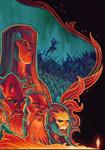
Information about
TyrannyDeveloper: Obsidian Entertainment
SP/MP: Single-player
Setting: Fantasy
Genre: RPG
Combat: Pausable Real-time
Play-time: 20-40 hours
Voice-acting: Partially voiced
Regions & platforms
Internet
· Homepage
· Platform: PC
· Released: 2016-11-10
· Publisher: Obsidian Entertainment
More information




